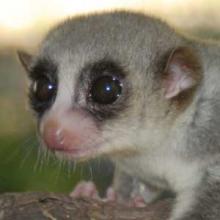The fat-tailed dwarf lemur is one of the smaller members of the genus Cheirogaleus. Head-body length is 17–23 cm, tail length is 19–27 cm, total length is 40–50 cm, and body weight varies seasonally from 120 to 270 g (Petter, 1978; Fietz and Ganzhorn, 1999; Müller, 1999b; Groves, 2000). According to Groves (2000), the dorsal coat is a light frosted fawn-gray with a brown midline stripe. The ventral coat is creamy or yellowish, somewhat more yellow toward the median. There is a partial but sharply marked white collar that extends well up the sides of the neck. A white median facial stripe is offset by dark brown eye rings. The hands and feet are white.
In his revision of the genus, Groves (2000) considered populations from the tropical dry lowland forests and spiny forest regions of the southwest to be a distinct species, and resurrected the name Cheirogaleus adipicaudatus (A. Grandidier, 1868). In terms of morphology, this taxon was said to be similar to C. medius, but with less contrasting colors and a tail that was longer than the head-body length. Groves (2000) examined specimens from three southern Madagascar sites: Tabiky, Tolagnaro (= Fort-Dauphin), and a third unnamed location 170 km east of Toliara (= Tuléar). Most likely representing a collection in dry spiny forest to the west of Tolagnaro. The presence of C. adipicaudatus in the region of Tolagnaro was not supported by Hapke et al. (2005), whose findings indicated instead the presence of three other Cheirogaleus species from that region (C. crossleyi, C. major and C. medius). It may be that the features on which this species was differentiated from C. medius (see Groves, 2001) characterize only a particular population of restricted distribution (C. P. Groves, pers. comm.). In any case, as indicated above, we follow Groeneveld et al. (2009) in considering C. adipicaudatus a synonym of C. medius. Groeneveld et al. (2009) found five terminal clades within C. medius, however, which may turn out to be distinct species.
In the field, Cheirogaleus is most likely to be confused with Lepilemur or Mirza, and possibly Microcebus, although it tends to move more slowly than any of these three. It can be distinguished from Lepilemur by its distinctive lighter underparts, by the form of its tail, and by body posture and movement; Lepilemur is more likely to adopt a vertical posture and to leap, whereas Cheirogaleus walks slowly and quadrupedally (although it is capable of leaping as well). Sportive lemurs are three to eight times the size of C. medius. Mirza has large distinctive ears and moves both rapidly and constantly. Microcebus also has highly visible ears, moves more than does Cheirogaleus, and is much smaller. Confusion with Phaner is unlikely, since Phaner moves constantly, vocalizes loudly, bobs its head back and forth, and has a more elongate face and telltale fork-mark pattern on its head. Distinguishing among species of Cheirogaleus is possible through the geographic location and using the detailed descriptions found in this section.
